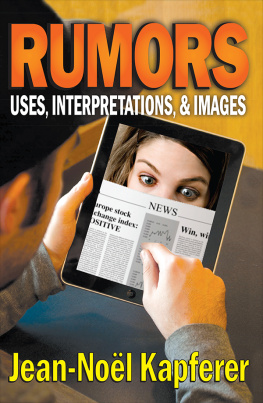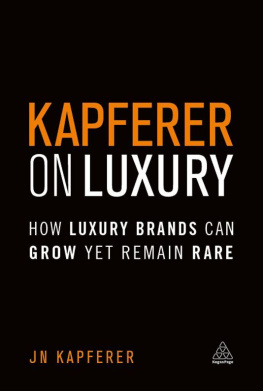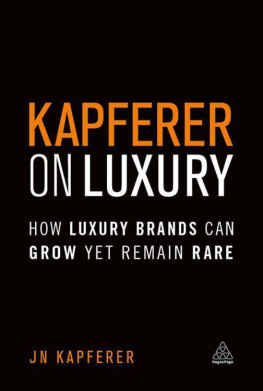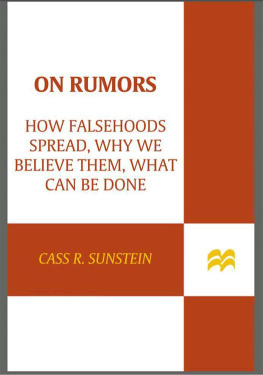Originally published in 1987 as Rumeurs: Le Plus Vieux Mdia du Monde, by Editions du Seuil, Paris. Revised edition published in English. Translated by Bruce Fink.
Published 1990 by Transaction Publishers
Published 2017 by Routledge
2 Park Square, Mliton Park, Abingdon, Oxon 0X14 4RN
711 Third Avenue, New York, NY 10017, USA
Routledge is an imprint of the Taylor & Francis Group, an informabusiness
Copyright 1990 by Taylor & Francis.
All rights reserved. No part of this book may be reprinted or reproduced or utilised in any form or by any electronic, mechanical, or other means, now known or hereafter invented, including photocopying and recording, or in any information storage or retrieval system, without permission in writing from the publishers.
Notice:
Product or corporate names may be trademarks or registered trademarks, and are used only for identification and explanation without intent to infringe.
Library of Congress Catalog Number: 89-20413
Library of Congress Cataloging-in-Publication Data
Kapferer, Jean-Nol.
[Rumeurs. English]
Rumors: the world's oldest media / Jean-Nol Kapferer:
translated by Bruce Fink.
p. cm.
Translation of Rumeurs.
Includes bibliographical references.
ISBN 0-88738-325-4
1. Rumor. I. Title.
HM291K17613 1990
302.24dc20
89-20413
CIP
ISBN 13: 978-1-4128-5155-8 (pbk)
ISBN 13: 978-0-88738-325-0 (hbk)
In 1981, Procter & Gamble, one of the biggest American producers of mass-consumption articles, received several thousand phone calls every month from worried consumers wanting to know whether the company had dealings with Satan, as rumor had it. The company's emblema human face contemplating myriads of starswas said to hide within it a great many Satanic signs. If one looked closely, the stars traced out the Devil's number: 666. Procter & Gamble was rumored to have made a pact with the Devil in order to increase sales, and was sending 10 percent of its profits to a satanic sect. Flaring up around 1980 in western Mississippi, this rumor spread rapidly, and soon reached the East Coast. It brought on a war for which Procter & Gamble was in no way prepareda star wars of an unusual ilk. Shaken up by the meaning of these innocent stars, many religious groups even started boycotting products marked with the fatal symbol. A leaflet began circulating telling consumers which brands they should boycott. In 1987, a translation of the leaflet began circulating in France among the country's most religious populations.
Towards the end of 1966 in Rouen, a good-sized town in the northwest of France, rumor accused a well-known dress shop of being a front for white slave trading. The shop's phone rang off the hook with threatening calls. Pursued by the rumor, which no amount of denials succeeded in dispelling, the store's manager opted to give up the fight and leave town. Three years later, the same kind of rumor plagued Orlans in the Loire Valley. Clients deserted six widely known clothing stores run by Jews, word having it that young women were being kidnapped in the dressing rooms. Inspecting the basements of these stores, police were said to have found two or three young girls who had been drugged and were about to be handed over to a white slave trade network. The rumor took on considerable proportions, requiring full mobilization of the Parisian as well as local press to snuff out what came to be known as the Orlans rumor, or to at least reduce it to silence.
In January 1973, a rumor ran rife in both majority and opposition political circles. Georges Pompidou, the president of France, was said to be seriously ill, his life being imperiled; he would thus be unable to complete his sevenyear term. Word leaked out across the nation, and was relayed by the press and media which spurred on questioning. Though never officially confirmed, the president's illness was in the conversational top ten. Pompidou in fact succumbed to a terrible disease one year later.
On November 22, 1963, John Fitzgerald Kennedy was assassinated while the presidential cortge paraded through Dallas. The guilty party was almost immediately identified as Lee Harvey Oswald. An official commission was assigned the task of investigating this dark moment in America's history. Its conclusions, spelled out in the famous Warren Report, showed not the slightest uncertainty: President Kennedy was affirmed to have been assassinated by one single person, L. Oswald, acting under his own initiative. Right after the assassination, however, a rumor sprang up to the effect that there had been several gunmen in Dallas that day and thus a real conspiracy. Some people mentioned Fidel Castro, others the CIA, and still others the Mafia. What is clear is that the official hypothesis of one isolated gunman never convinced a certain portion of American public opinion.
All four of the above rumors were widely known. In each and every case, the same process took place. An idea, coalescing out of thin air, started proliferating and circulating. Its movement gained speed, reached a climax before falling off, split into small brush fires, and then faded, in most instances, into total silence. These four examples are, however, quite heterogeneous. The Orlans rumor was utterly groundless. Similarly, Procter & Gamble had nothing to do with the Devil. The rumor concerning President Pompidou's terminal illness was, on the contrary, altogether founded. And as for the rumor challenging the conclusions of the Warren report, uncertainty has never been dispelled, and room for doubt remains.
For the public, the word rumor conjures up a mysterious, almost magical phenomenon. An analysis of common terms used is revealing in this respect: rumors fly, crawl, slither, brood, and run rife. Physically speaking, rumors are surprising animals, swift and insatiable, belonging to no known family. Their effect on men seems to be akin to that of hypnosis: they fascinate, subjugate, seduce and set them ablaze.
The main thesis in this book is that this conception is erroneous. Rumors, far from being mysterious, comply with a strict logic whose mechanisms can be demonstrated. We can better answer today the important questions raised by rumors: how do they arise? Where do they come from? Why do they appear on a particular day in a particular group or in a particular place? One can also interpret rumors: why do they always relate misfortune? What rules does a rumor's message obey? Beyond its apparent content, what is its hidden message?
Moreover, one cannot analyze the phenomenon of rumors without speaking of their role in everyday life. How do we live with rumors, how do we use them, for what purposes, and with what expected or unexpected consequences?
And a final question: can one snuff out a rumor? Up until now, most researchers have confined themselves to furnishing a descriptive or explanatory analysis of the phenomenon; but social realities require us to stride beyond analysis on towards prescription. Above all, it is through in-depth study of the problem of rumor control that one pierces to the very heart of its logicto the fundamental phenomenon of belief.











